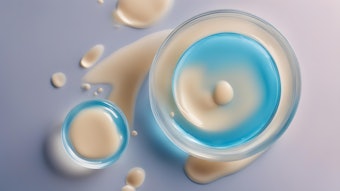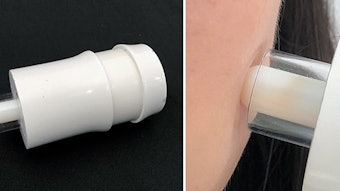
Ticking, heating and tingling sensations resulting in discomfort and sometimes pain or pruritus characterize reactive, sensitive skin. These reactions can originate from physical factors, i.e., UV rays, heat, cold and wind; chemical factors such as cosmetics, soap, water and pollution; psychological stress; or hormones, i.e., the menstrual cycle.1, 2 From a biological view, these phenomena impact the systems shown in Figure 1; for example, the nervous system, involving C-nerve fibers located in the papillary dermis and epidermis.
In hyper-reactive skin, free nerve endings have abnormally high sensitivity. Their stimulation leads to the release of neuropeptides such as substance P or calcitonin gene-related peptide (CGRP). On the other hand, external aggressions induce both the release of pro-inflammatory mediators by immune cells from keratinocytes and neutrophils (PMNs), and histamine degranulation by mast cells and basophils.
This bidirectional cross-talk between the nervous and immune systems is exemplified in the case of neurogenic inflammation. In this skin condition, the induction of neuropeptides by inflammation mediators and the expression of neuropeptide receptors on inflammatory cells intensify the formerly described cascade reactions.3 These reactions drove development of an Embelia concinna-based, flavonoid-titrated active ingredienta, which previously was shown in vitro to calm and sooth sensory neurons stimulated with capsaicin. Here, in vitro results are compared in vivo using a capsaicin stinging test on volunteers.
Embelia Mode of Action
To understand this ingredient’s activity, consider some facts. E. concinna Baker, a plant endemic to Madagascar, is a member of the Myrsinaceae family. It is an evergreen climbing shrub that grows widely between altitudes of 1,200-2,000 m. Embelia bears bright red, round fruit when it is mature.4 It has numerous local names in Madagascar, the most common of which, Tanterakala, may be translated as “the hug of the forest.” This refers to the plant’s liana-like behavior, growing on nearby trees by wrapping itself around them.
E. concinna traditionally has been used in Madagascar for the de-worming, i.e., antiparasitic, properties of its roots as well as its ability to stop bleeding.5 The leaves are also decocted to produce a preparation that treats coughs and neuralgia, and provides tonic properties. The lignified leaves and twigs are also used to prepare an infusion for the treatment of joint pains, and their sap is used to treat burned skin and ulcers.
Several families of molecules have been identified particularly in the leaves of E. concinna; among them, flavonoids are main type responsible for the inherent biological properties of the active.6 Thus, the present active was developed from this source to calm and sooth reactive and neurosensitive skin.
In vitro results: As noted, previous studies3 showed the active decreased the release of neuromediators. Pre-treating sensory neurons with the active before stimulation with capsaicin reduced the release of substance P and CGRP in a dose-dependent manner (see Figure 2 and Figure 3). Mast cells and human basophils pre-treated with the active ingredient before stimulation with a mast cell–degranulating agent compound 48/80 (CP48/80) showed reduced histamine release (data not shown). Further, human neutrophils pre-treated with the active and then stimulated with a zymosan macrophage activator resulted in reduced release levels of PGE2 and LTB4 release (data not shown). These results led to the present in vivo capsaicin test in human volunteers.
Materials and Methods
A double-blind, 28-day study was conducted with 46 volunteers presenting dry, reactive and sensitive skin. Two days prior to the study (D−2), a capsaicin test was performed on nasolabial folds following a method described elsewhere7 to preselect volunteers having sensitive facial skin with a detection threshold corresponding to the most diluted capsaicin solution. The subjects were divided in two groups of 23; one tested a minimally moisturizing placebo product without the extract, and the other tested the same product containing 2% embelia extracta. For the 28 days, D0 to D28, volunteers applied the products to the face twice daily.
On D0, D7 and D28, the capsaicin test was performed as it was at D−2 and the volunteers were asked to rate the sensations felt after application of the capsaicin solution, stating precisely the side, nature, i.e., discomfort, stinging, burning, itching, tightness, etc., and intensity using the following scale:
0: no sensation
1: doubtful, barely perceptible
2: slightly perceptible
3: moderately perceptible
4: strongly perceptible
5: painful
Additionally, a subjective evaluation with a questionnaire, prepared by the clinical trial center, was filled in by the volunteers on D28 to evaluate the efficacy of the studied products.
Results and Discussion
Comparing evaluations with and without embelia extract, the sensation intensity scores at D7 and D28 for the embelia group significantly decreased. Additionally, the subjective evaluation with the questionnaire reinforced those results, showing an increase in volunteers’ satisfaction from the embelia product compared with the placebo product.
As shown in Figure 4, after seven days, no significant effect on the sensation intensity score was observed in the placebo group, compared with the baseline at D−2. However, a significant decrease of 23% was observed in the embelia group. Similarly, after 28 days, compared with the baseline at D−2, the placebo group showed a decrease of 21% but the embelia group exhibited twice that—a 42% decrease. The decrease in the placebo group may be explained by the moisturizing effects of the test formula. Overall, these results indicated the active had positive effects in the mid- to long-term against discomfort sensation induced by capsaicin.
As shown in Figure 5, the subjective evaluations of volunteers from the embelia group compared with the placebo group indicated the embelia provided more comfort after 28 days of treatment. Here, 95% of the embelia group agreed or somewhat agreed with the statement “the product calms irritation and soothes skin,” whereas only 83% of the placebo group agreed or somewhat agreed with this statement. The questionnaire also indicated 91% of the volunteers in the embelia group wanted to continue using the product, and 83% would replace their usual product by the test product.
Conclusion
In summary, this study used capsaicin to validate the ability of the embelia-derived active ingredient to provide medium- to long-term calming and soothing effects against discomfort for volunteers presenting with dry, reactive and sensitive skin. This in vivo test corroborated previously observed in vitro results.3 The active ingredient’s specific mechanism of action related to neurogenic inflammation could be further detailed with additional investigations in face care and scalp applications.
Having a positive impact on both the nervous and immune systems, as well as on constitutive inflammation, the embelia active discussed addressed sensitive and reactive skin. This suggests its application to counteract environmental aggressions for neurocosmetic purposes.
References
- L Misery, S Boussetta, T Nocera, N Perez-Cullell and C Taieb, Sensitive skin in Europe, Jeadv 23 376-381 (2009)
- L Misery, E Myon, N Martin, F Verriere, T Nocera and C Taieb, Sensitive skins in France: An epidemiological approach, Ann Dermatol Venereol 132 425-9 (2005)
- V Petit et al, New insights on embelia extract versus hyper-reactive skin, IFSCC Paris (2014)
- H Perrier de la Bathie, Fl Madagasc 161 1–142 (1953)
- S Heitz, CR Acad Sci Hebd Seances, Acad Sci D 277(16) 1703-4 (1973)
- J Bruneton, Pharmacognosy, Phytochemistry, Medicinal Plants, Lavoisier, Cachan Cedex, France (1999)
- Bayer HealthCare Division Serdex, reference study 13E0570 (internal)










